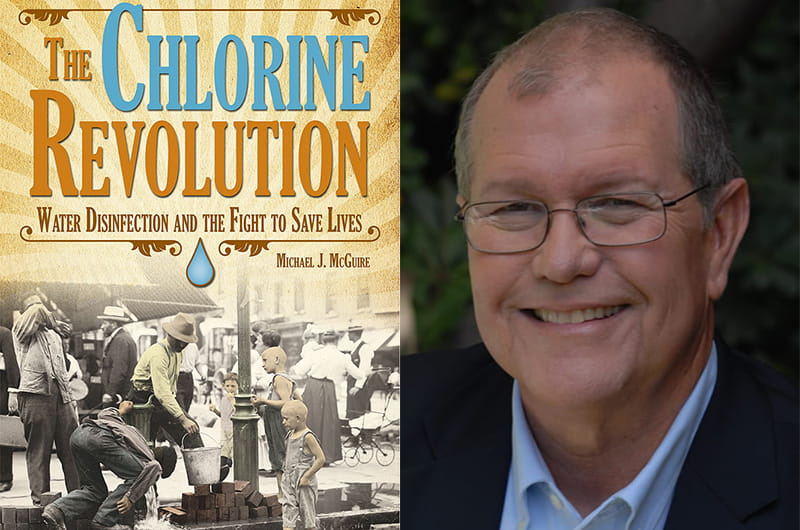How Two Men Helped Rid the U.S. of Typhoid: A Q&A With Drexel Alumnus Michael McGuire

- Bolstered by Research Consortium with Drexel, Jefferson’s Sidney Kimmel Cancer Center Earns NCI Comprehensive Cancer Center Designation
- Drexel’s Pearlstein Gallery Offers Spring Exhibitions Centered on the Healing Properties of Art and Creative Works
- Drexel's Self-Heating Concrete Is One Step Closer to Clearing Sidewalks Without Shoveling or Salting
- Pinging Pipes Could Help to Identify Lead Water Lines Without Excavation

If you grew up in the United States or any developed country during the past century, you probably didn’t spend much time worrying about typhoid fever.
And for that, you can thank physician John L. Leal and sanitary engineer George Warren Fuller, who pioneered the use of chlorine in municipal water supplies, and a fateful court case more than 100 years ago that took place in Jersey City, N.J., the first municipality with chlorinated water.
Michael J. McGuire, a Drexel alumnus, published a book about that 1908 case and its importance last year: “The Chlorine Revolution: Water Disinfection and the Fight to Save Lives.” He’ll be back at Drexel this week for a talk and book signing sponsored by the Civil, Architectural and Environmental Engineering Department. The event begins at 2 p.m. Thursday, April 3, in Room 112 of the Papadakis Integrated Science Building.
After earning his PhD from Drexel in 1977, McGuire moved into a career in environmental engineering and consulting that saw him achieve election to the National Academy of Engineering in 2009 for “scientific contributions that have improved the safety and aesthetics of drinking water.” In recent years, his work has turned increasingly to research and writing.
DrexelNow talked with McGuire about why the story of chlorination in Jersey City is so important.
Why did you decide that the use of chlorine in water was a subject worthy of a book?
My interest in chlorine history and water history started in 2005 when I wrote an article for the American Water Works Association’s Journal about the revolutions that occurred in U.S. drinking water disinfection over the previous 97 years. Chlorinating the Jersey City water supply in 1908 was the first revolution, and I became fascinated with the people who were responsible and with the barriers they faced to implement effective water treatment processes. At that time, waterborne disease was a leading killer, especially of very young children. What Dr. John L. Leal and George Warren Fuller did back then was extraordinary, and their exploits fed my desire to learn more about the roots of our profession.
Why were many scientists around the turn of the 20th century opposed to the use of chlorine in drinking water?
In the late 1890s, scientists and engineers reflected the views of the public. In 1894, Massachusetts Institute of Technology professor Thomas M. Drown declared that “the idea itself of chemical disinfection is repellent.” No matter that germs were known to cause disease, no matter that germs could be killed by disinfectants and no matter that water supplies were known to contain pathogenic organisms, public fear of adding chemicals to water was strong enough to prevent disinfection from being considered in the U.S. in the 1890s and early 20th century. During this period, typhoid fever and diarrheal diseases in children killed an astonishingly large number of people.
The public’s fear was fostered in part by foods being laced with cheap chemicals by unscrupulous food manufacturers. Medicines also were made from chemical stews that rarely cured anything.
What was the significance of the Jersey City court case you examine in the book?
A famous sanitary engineer and Yale professor, C.-E. A. Winslow, summarized it in a 1912 article: “This case will, I think, take its place as one of the historical law-suits in connection with the subject of water-supply.”
The success of the court case for the supporters of chemical disinfection brought about a permanent change in drinking water treatment and made it clear to the world that a revolution in public health had taken place.
Just how vast was the effect of the widespread use of chlorine after this court case?
Jersey City was the only utility using chlorine in 1908, but just six years later, more than 21 million people were receiving water from chlorinated municipal supplies.
The population served by municipal water supplies in 1914 was just over 40 million people. Fully 53 percent, or 21 million, of those 40 million people were known to be receiving water that had been disinfected with chlorine. And this number does not include the customers of utilities that were using chlorine but did not respond to a questionnaire in 1908.
Over the next few decades, typhoid fever disappeared and massive deaths of children less than one year of age were drastically curtailed. All of these public health improvements can be traced to the use of filtration, but most importantly to the implementation of chlorine disinfection. As I am fond of saying, “If you have lived a nice, long life, don’t thank your doctor. Thank an engineer.”
In This Article
Drexel News is produced by
University Marketing and Communications.
